
WW2 white metal Government Issue Cap Badge
for the Seaforth Highlanders of Canada,
with brass
shoulder titles and Collar Badges
of the Canadian Seaforths
(Credit for photographs of the badges goes to Clifford Weirmeir, with his splendid website about
the Irish
regiment of Canada)
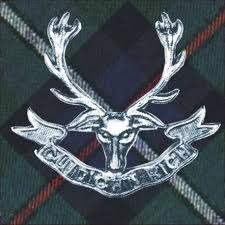
the cap badge of the parent
Regiment: the Seaforth Highlanders of Scotland

This Seaforth Highlanders of Canada Helmet Flash
Decal was worn on the left side of the MK II Helmet

The MacKenzie Tartan of the
Seaforth Highlanders of Canada

The Hague, 21 May 1945, Victory
Parade.
The boy shown on the left, who 22 years later
would become the
Drum Major of the "Haagse Hooglanders", walked along for miles with P/M Edmund Esson (P.M. of the Canadian Seaforths).

But before this, a lot had to happen.
The Seaforth Highlanders of Canada, after mobilization, first
had to be shipped to Great Britain for more more training and
re-equipment in preparation for battle. While over there, they
visited the "Imperial" Seaforth Highlanders, who supplied them
with their own cap badges
(see below here),
The
Canadian Seaforths
preferred to wear those instead of the newly designed Canadian
government issue hat badges
(as seen on the first photo, above
here on this page)
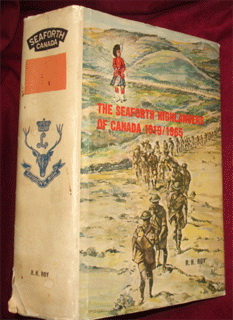
From The Seaforth
Highlanders of Canada 1919/1965 Note 18,19 p52:
-
On the tunic all ranks wore the regimental collar
badge "in gilt, a Cougar, standing". (General Order 111, dated
15 July 1923.)
- Officially the regimental cap badge is described in General
Order No. 111 of 1923 as: "In silver, a stag's head, with the
letter 'L' and a coronet, set between the antlers, the whole
resting on a scroll bearing the Gaelic motto 'CUIDICH'N RIGH'."
The shoulder badge was described in General Order 94, of 15 June
1928, in these words: "In Gilt, the title 'SEAFORTHS' in half
inch letters in the form of a quarter circle." Other ranks wore
the same, but in brass. The hat badge supplied to the unit
before and during the war did not conform to that worn by the
affiliated regiment, and despite unending correspondence over a
decade, the Seaforths were unable to have the badge they wanted
issued to them.
Consequently, the Seaforths had their badges privately
manufactured to ensure its conformity with the "imperial"
Seaforths

From The Seaforth
Highlanders of Canada 1919/1965 Note 7 pp74-75:
"About a year after the unit had been in Great Britain two
additional distinguishing marks were added to the men's uniform.
One was the cloth shoulder badge - with "Seaforth-Canada"
embroidered in buff on a dark blue background. The other was a
two-and-a half square decal of the Mackenzie tartan with the
regimental badge imposed on it. This was pasted on the left side
of the helmet."
(see below)

Canadian Seaforths' war-time helmet decals with the same stag's head
motif as the Seaforths'
metal hat badges

Senior Pipe
Major Edmund Esson, still without beard or even moustache (front row, on the far right) in London
with other Canadian Pipe majors
THE MOVE TO
GREAT BRITAIN

From The Seaforth
Highlanders of Canada 1919/1965:
A lot of
preparations had to be made for the move from Vancouver to
Britain.
There was also the question of bringing over the
pipes and drums, for many of the pipers owned their own
instruments and the drums were regimental property. Mr. George
Thompson, D.C.M, and Mr. W. M. Crawford, Vancouver businessmen
with a strong Scottish patriotism, helped to solve this question
with the result that Pipe Major Esson and the battalion as a
whole were able to bring overseas the nucleus of a first rate
Pipe Band.
When
the battalion received notice that it would be
leaving the city by two special C.P.R. trains on the morning of
the 15th December. Lt. D. M. Clark, the Acting Adjutant, had a
four-page movement order ready the next day, and early on the
15th everything was ready.
At nine o'clock the great doors of the Seaforth Armoury opened,
and the roar of the drums echoing inside the building brought
forth the Pipes and Drums playing "Scotland the Brave" as they
led the khaki columns out into the street.
They
swung
right over the Burrard bridge, and at the end of the bridge the
crowds thickened, and when the pipes struck up "Blue Bonnets
over the Border" when marching down Granville Street, there were
almost two battalions marching - one of soldiers and one of
civilians. Coming up in the rear the brass band was playing
marching songs from the Great War, and the combination of the
two-the shrill, defiant cry of the pipes and the solid, military
sound of the brass band-brought surges of emotion to the
thousands who cheered the regiment on its way.
Shortly after ten, the first of the two special
trains pulled away from the station, followed by the second
within the hour. It took five days to travel the 3000 miles
between Vancouver and Halifax. Periodically the trains stopped
long enough for everyone to get out and either do some physical
training exercises on the station platform or go on a short
route march. In Winnipeg the Pipe Band of the Cameron
Highlanders met the unit and led the men on a short route march.
At noon on 20 December the battalion pulled up
close to the Halifax dock. They were to board the H.M.T. Andes. At noon on 22 December the convoy
began to move past the rocky harbour coast which looked bleak
through the snow flurries.

H.M.T. Andes
Details on Her Majesty's
Troopship Andes
Operating life: 1939
- 1971 - Tonnage: 25,689 - Passengers: 607
Constructed: Harland & Wolff, Belfast, Andes was launched 6
months before the outbreak of World War Two. She was immediately
requisitioned as a troop carrier and spent the war on active
duty. In 1947 she was released back to the Royal Mail Line and,
after a major refit in Belfast, she commenced her commercial
service on routes to South America. In 1959 she was refitted for
cruising. In 1971 she made her last voyage to the breakers in
Belgium.
The morning of the 30th of December, as dawn
broke, they were between the black but welcome hills of the
mouth of the River Clyde, in Scotland. As the sun rose small
white-washed cottages appeared on either bank, becoming more
numerous as they reached the boom ships near Gourock. By
mid-morning the Andes was at anchor. Then they had to travel by
train towards their destination.
Among the several hundred men on the earlier
train section commanded by Major Ferrie, there was one group of
men who had an inward glow sufficient to overcome the bleak
weather outside. That was the pipe band. "We all wondered why
our Pipe Band was so enthusiastic in playing at every stop made
by the train on our way to Aldershot," Ferrie wrote. "It turned
out that they had raided the bar on the train and got well
fortified on `Scotland's Best'. However, it was docked from
their pay and everyone was happy except the Pipe Band."
Pipe Major Esson's version is different. He
claims he was playing in the New Year on the pipes as a good
Scotsman should, when some of the train crew, in appreciation,
brought up some refreshments for him and other pipers. To refuse
would be discourteous, and the Seaforth pipers were all
gentlemen.
The long, cold train journey from Glasgow to
North Farnborough came to an end at mid-morning on New Year's
Day, 1940, when everyone piled out of the carriages onto the
icy, snow-covered platform. Here the battalion was met by
Brigadier Pearkes, several staff officers from the Aldershot
Command, as well as part of the Advance Party which had been
getting their quarters in shape for the past week. A two-mile
route march brought the unit to the Delville Barracks. Thus the
training period in Britain started.

Then,
before being sent into action in Libya to gain combat experience
with the British 51st. Highland Division, Pipe Major Edmund Esson decided
to symbolically let his beard grow for the duration of the war,
and take it off only after it would have ended.

Edmund Esson, as senior
Pipe major, in tropical dress with specially made brassards
showing his P.M.'s stripes,
and the 3d. silver glengarry badge also shown below here.

The massed Pipes and
Drums of the 51st. Highland Division
marching past in Tripoli, March 1943.
(Photograph courtesy of the Museum of The Black
Watch)
In early 1943,
Pipe Major Edmund Esson was posted with the "Imperial" Seaforth
Highlanders in the 51st. Highland Division to gain battle
experience in North Africa, and so he was in for the kill, when
Tripoli was taken.
4 February 1943, Churchill took the salute at the Tripoli
victory parade.
A large Highland pipe band was in attendance.
As
the Senior Pipe Major of the entire Imperial
British army, Edmund Esson
had the honour of leading the massed pipe bands in the victory
parade through Tripoli which made him become world-renowned and
the fact that he sported a beard at a time when few Army men
did, which made him even more noticeable.

the Victory Parade at
Tripoli,
4 February 1943.
The Massed Pipes & Drums can be
seen in the foreground.

Seaforth Highlander Pipe Major's three-dimensional silver badge

THE MOVE TO
SICILY - ITALY
At about
the time that Lt-Col B.M. Hoffmeister took command of the
Battalion in October 1942, the focus of training shifted from
the coastal defence of England to landings on enemy occupied
coasts. After much intense training both in England and
Scotland, by May 1943 the Seaforths knew they were finally going
into action though the destination was still a mystery. On the
18th of June the Battalion was ordered to board L.S.I. Circassia
[see below for details].
After more than a week of further assault training the Circassia
began it's journey down the Clyde at 2100 28 July. It was not
until July 1st that the Seaforths learned that they were to
attack Sicily in Operation "Husky".
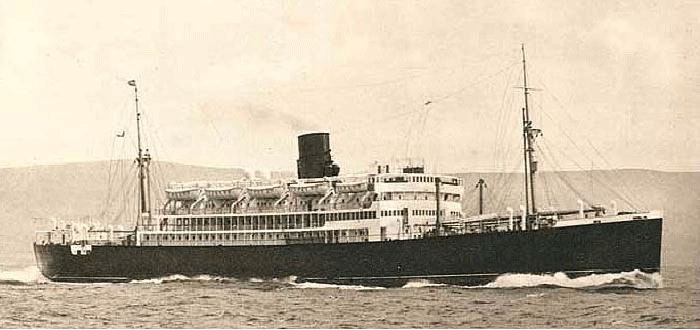
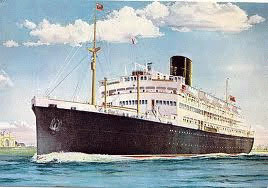
The Circassia was one of two identical ships built
by the Firfield Shipbuilding & Engineering Co. of
Govan: the Circassia and the Cilicia
Details on HMS Circassia (F 91):
Armed Merchant Cruiser The Royal Navy Built by
Fairfield Shipbuilding & Engineering Co. (Govan, Scotland) ,
Launched 8 Jun 1937 Commissioned 20 Dec 1939 End service 5 Mar
1942.
History On 14 October 1939 the passenger ship Circassia of the
Anchor Line (Henderson Bros) Ltd, Glasgow was requisitioned by
the Admiralty and converted to an armed merchant cruiser.
Conversion was completed on 20 December 1939. Displacement:
11136 BRT Armament: 8x 152mm, 2x 76mm Speed: 16 knots
On 5 March 1942 returned and used as troopship by the Ministry
of War Transport (MoWT). 1943 converted to a landing ship LSI(L).
On July
10, 1943 the Canadian Seaforths Landed in Sicily, Italy.
They would remain in action there, fighting the "Battle of the
Rivers" until on the 13th. of March 1944 they were transferred
to the battle area in North West Europe for the campaign in the
Netherlands.

photograph taken in Sicily, of the
Retreat on the evening of 28th. July, 1943, after Agira
had been captured.

From The Seaforth
Highlanders of Canada 1919/1965,
Chapter 06, The Campaign in Sicily, page 190:
The Pipes and Drums had
always been the pride of the Seaforths and there
were times when only the pipes could express the
feelings of the battalion. Such was the case at
Agira. Since they had landed, the pipers and
drummers had been used for a variety of tasks
from "mule skinners" to helping with the
numerous jobs behind the lines which were vital
to keep the men at the front supplied. The dry
heat of Sicily played havoc with the settings
and tensions of both pipes and drums, but when
Pipe Major Esson was asked to beat "Retreat" in
the Town Square of Agira, he managed to round up
the band and have his instruments decently in
tune. It was the first time in weeks they had
played, but the shrill cry of those Scots tunes
never sounded sweeter than in that ancient town.
There was pride in every piece, and defiance in
every note. There would be times, later, when
the pipes would again sound their tunes of
glory, but there was something about that
"Retreat" played in Agira which would be
remembered with particular poignancy by all who
were there to hear it."

The Pipe Band of the Seaforth
Highlanders of Canada and the Lorne Scots (who did not have
their own pipes & drums with them)
taking part in the Changing of the 1st Canadian Corps Guard
ceremony,
Rocca, Italy, 1 March 1944.

Christmas dinner with the
Seaforths.
Christmas Day found the Seaforths in the
frontline. They had their Christmas dinner with all the
trimmings, later in the town hall at Russi, about 12 miles
behind the front. Here are diners shown eating turkey and other
goodies while pipers of the regiment play during the meal.
credit:(CANADIAN ARMY OVERSEAS PHOTO)19/1/45
The story of this remarkable
event is also told in the Regimental History, see below:

From The Seaforth
Highlanders of Canada 1919/1965, page268:
C Company
was the First to eat diner in the church, a
diner non had felt possible under such
conditions, but no one had truly tested the
ingenuity and resourcefulness before the QM and
staff. From 11.00 to 19.00 hours, when the last
man of the Battalion reluctantly left the table
to return to the grim realities of the day,
there was an atmosphere of cheer and good
fellowship in the church, a true Christmas
spirit. The impossible had happened. No one had
looked for a celebration this day. December 25th
was to be another day of war. The expression on
the faces of the dirty bearded men as they
entered the building was a reward that those
responsible are never to forget. When C Company
had finished their diner they relieved A Company
so that they might come back the 300 or 400
yards for the same. Christmas Day was no less
quiet then the preceding ones, but it is one the
Regiment will never forget. PM Esson played his
pipes several times throughout the meals. During
the diner the Signal Officer, Lt W. Gildersleeve,
played the church organ and, with the aid of an
improvised choir organized by the padre, carols
rang throughout the church.

Three Canadian Seaforths' Pipers in
shirtsleeve order (wearing the horsehair sporran) posing with a
drummer.


Canadian Seaforths' memorial service with bugler
sounding the Last Post during the burial service at Ortona, early in 1944.
Next, the Lament was played by Pipe Major Edmund Esson.
February
28, 1944 the Commanding Officer was informed that in a week's
time the Canadian Seaforths should be ready to be transferred to
the battle area in North West Europe.

THE MOVE TO
FRANCE and HOLLAND

official map of "Operation
Goldflake", the move of 1st. Canadian Corps to Belgium
L.C.I. -T Class Landing Craft Infantry (Large),
number 48 was used to transport the Seaforth
Highlanders of Canada to Marseille, France


Photograph 1, left:
loading French Colonial 9th Infantry Division troops
at Porto Vecchio, Corsica, 16 June 1944, for the Invasion of
Elba, 17 June 1944. Note the censorship of the radars.
Photograph 2, right: USS LCI(L)-48 and USS LCI(L)-221 and an
unidentified LCI(L) beached, date and location unknown. Photo
from the US Library of Congress collection.
Details on
the LCI (L) 48:
USS LCI(L)-48
LCI-1 Class Landing Craft Infantry (Large):
Laid down, 5 November 1942 at New York Shipbuilding
Corp., Camden, N.J
Launched, 10 December 1942
Commissioned USS LCI(L)-48, 9 February 1943
During World War II LCI(L)-48 was assigned to the
Europe-Africa-Middle East Theatre and participated
in the following campaigns:
Europe-Africa-Middle East Campaigns Campaign and
Dates Campaign and Dates
Sicilian occupation, 9 to 15 July 1943 West Coast
of Italy operations
Anzio-Nuttuno advanced landings, 22 January to 1
March 1944
Elba and Pianosa landings, 17 June 1944
Salerno landings, 9 to 21 September 1943
Invasion of Southern France, 15 August to 18
September 1944
USS LCI(L)-48 earned four battle stars for World War
II service
--------------------------------------------------------------------------------
Specifications:
Displacement 216 t.(light), 234 t.(landing), 389
t.(loaded)
Length 158' 5˝" - Beam 23' 3"
Draft Light, 3'1˝" mean, Landing, 2' 8" forward, 4'
10" aft, Loaded, 5' 4" forward, 5' 11" aft
Speed 16 kts (max.), 14 kts maximum continuous
Complement 4 Officer, 21 Enlisted
Troop Capacity 6 Officers, 182 Enlisted
Cargo Capacity 75 tons
Armor 2" plastic splinter protection on gun turrets,
conning tower and pilot house
Endurance 4,000 miles at 12 kts, loaded, 500 miles
at 15 knots; and 110 tons of fuel
Armament four single 20mm guns one forward, one
amidship, two aft, later added two .50 cal machine
guns
Fuel Capacity 130 tons, lube oil 200 gal.
Propulsion two sets of 4 GM diesels, 4 per shaft,
BHP 1,600, twin variable pitch propellers

From The Seaforth
Highlanders of Canada 1919/1965:
The voyage on board the "L.C.I. 48", from Italy
to Marseill, France, lasted little more than 24 hours.
By 0800 hours on 15 March the outline of the
southern coast of France came into view and an hour later the
craft was easing its way into the cluttered harbour at
Marseilles. By mid-morning the battalion disembarked and
embussed on waiting T.C.Vs. which took the men to a huge staging
or transit camp some twelve miles north of the seaport. Later
that evening the drivers of the jeeps and unit vehicles which
had come to Marseilles on a L.S.T. rolled into camp and the unit
was complete.
For the next week the Seaforths were shuttled
from one staging camp to another on their way to Belgium. By the
21st of March the journey of over 1700 miles ended when the
Seaforths crossed over the border into Belgium and the companies
were directed to their billets in the small villages of
Westmeerbeek, Houvenne and Ramsel.
Almost immediately the Seaforths were ordered to
sew up their unit and divisional patches
(which, like the vehicle identifying signs, were removed before
the move for security reasons). Vehicles
had their identifying signs painted on by drivers and mechanics
who were also busy checking the wheeled vehicles after their
long journey.
For the next three days the Seaforths remained in
the Reichswald, making themselves as comfortable as they could
in the raw, rainy weather which made the dark, black earth a
gluey mud. By mid-morning on 7 April the Seaforths, along with
the rest of the brigade, were on the move north. Shortly after
noon the Seaforths arrived at their area a short distance south
of Baak. Two miles to the west was the IJssel River.

The liberation of Amsterdam
on the 8th. of May, 1945
After crossing the river
IJssel in the Netherlands, the Canadian Seaforths fought their
way towards the West. On 21 April when the battalion moved to
take up billets in a number of farm houses about two miles south
of Barneveld. On the 23rd the battalion moved two miles further
west to the small village of De Glindhorst and after the German
capitulation, at 0800 hours on 8 May they left from where they
were at De Glindhorst and drove through Amersfoort, Baarn and
Bussum towards Amsterdam, where they were stationed for some
time, and the pipe band would play for church parades and
liberation festivities. The Seaforths were very enthusiastically
received in town and became the big heroes of Amsterdam for
ever.

From The Seaforth
Highlanders of Canada 1919/1965:
Waiting for us were thousands of people of all
ages, lining the sidewalks and encroaching on the roadway to
such an extent that the convoy was forced to slow down and
finally stop. Immediately every vehicle was smothered under a
mountain of humanity. Every part of a vehicle offering support
or a hand-hold was used.... However, there was no scraping them
off and it was with the greatest difficulty that the convoy was
able to move again under the guidance of a member of the N.B.S.
... We were led by a very circuitous route to the Vondelspark
... where the swarming civilians were gradually herded out. . .
In the convoy was Padre Durnford who wrote in his
diary:
Amsterdam. Thousands upon thousands upon
thousands line the streets for four miles. Flowers-roses,
tulips, and every sort. Crowds load every vehicle including our
R.A.P. jeep. I ,stand on running board. Terrific welcome.
Nothing like it in history of Holland. They tell in broken
English with tears and unbridled joy how thankful they are to
us. Children are lovely. Terrible shortage of food. . . .
An N.C.O. in "C" Company added:
The reception we received from the population
along the entire route was something we'll always remember. On
the outskirts of the city the people mobbed the vehicles.... It
was more than your life was worth to pull out cigarettes.... All
evening crowds were thronging around our billets.... When a
soldier steps out of a house dozens of children mob him for his
signature'. . . .
And as the Adjutant wrote home a few days later,
summing up the feeling of most Seaforths: "There were flags and
streamers and smiles and cheers and everywhere such obvious
happiness as to stir the soul most deeply. . . ."

fraternization was no
problem in friendly Amsterdam


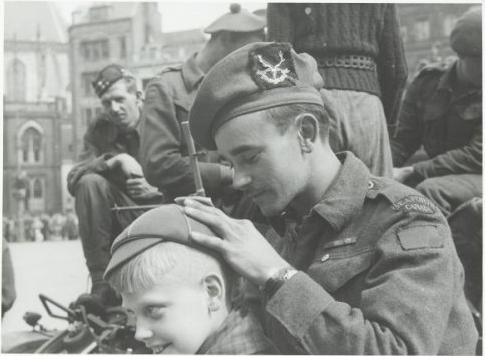

although it sometimes did look as if all the
Dutch did was collecting signatures!

But some would also offer
their liberators bunches of flowers, such as tulips in this
case.

Since then:
 On 21 May 1945, P.M. Edmund Esson was leading Pipe major at the
First Canadian Army Massed Pipes and Drums at
the
The HagueVictory Parade.
On 21 May 1945, P.M. Edmund Esson was leading Pipe major at the
First Canadian Army Massed Pipes and Drums at
the
The HagueVictory Parade.

 On 10 June the Seaforths'Pipes & Drums took part
in a First Canadian Army division parade at Rotterdam. This was
a most impressive demonstration of the division's strength, not
only of men, but of hundreds of guns, vehicles, carriers,
armoured cars, self-propelled guns and other military equipment
which most men in the battalion had never seen all together at
one spot. It took close to two hours for this demonstration of
armed power to pass, even though the infantry battalions marched
eight abreast. The marching troops were led by the Pipes and
Drums of the Seaforth Highlanders of Canada and the 48th
Highlanders of Canada under Pipe Major Esson.
On 10 June the Seaforths'Pipes & Drums took part
in a First Canadian Army division parade at Rotterdam. This was
a most impressive demonstration of the division's strength, not
only of men, but of hundreds of guns, vehicles, carriers,
armoured cars, self-propelled guns and other military equipment
which most men in the battalion had never seen all together at
one spot. It took close to two hours for this demonstration of
armed power to pass, even though the infantry battalions marched
eight abreast. The marching troops were led by the Pipes and
Drums of the Seaforth Highlanders of Canada and the 48th
Highlanders of Canada under Pipe Major Esson.

10 June, the First Canadian Infantry Division
parade at Rotterdam
 P.M. Edmond Esson and
his Pipe Band again took part in
festivities in Brussels on
11 June 1945, where he led the Canadian Massed Pipes &
Drums.
P.M. Edmond Esson and
his Pipe Band again took part in
festivities in Brussels on
11 June 1945, where he led the Canadian Massed Pipes &
Drums.

Ed Esson on parade in Brussels 11 june 1945,
at the Parc du Cinquantenaire
 And on
28-06-1945 the Amsterdam three days Liberation Festival was
held, where again
Pipe Major Edmund Esson,
who now wore his M.B.E. ribbon but no longer his beard, was the leading Pipe
major.
And on
28-06-1945 the Amsterdam three days Liberation Festival was
held, where again
Pipe Major Edmund Esson,
who now wore his M.B.E. ribbon but no longer his beard, was the leading Pipe
major.

Parade after the impressive memorial
service at the Oosterkerk, Amsterdam on the 23rd. of May.
The
Seaforths' appearance as they paraded through the streets of
Amsterdam was as smart as if they had marched from barracks in
England in 1940


Scores of kids and other spectators
watched the Pipe Band play near the "Tropeninstituut" in
Amsterdam.
In fact some of those kids, inspired by this,
years later started the Amsterdam based Y.M.C.A. pipe band.
 In mid-month of July the Pipe Band also payed a visit to
all the "Imperial" Seaforths pipe bands
(of the 2nd.,5th.,6th. and 7th.
Seaforth battalions)
that were stationed together at Cuxhaven
in Germany, where a unique 100 pipers and drummers-strong Canadian/British Seaforths Massed Pipes and
Drums event took place.
In mid-month of July the Pipe Band also payed a visit to
all the "Imperial" Seaforths pipe bands
(of the 2nd.,5th.,6th. and 7th.
Seaforth battalions)
that were stationed together at Cuxhaven
in Germany, where a unique 100 pipers and drummers-strong Canadian/British Seaforths Massed Pipes and
Drums event took place.

From The Seaforth
Highlanders of Canada 1919/1965, p.443-444:
In mid-month the unit began to turn in its
vehicles, but fortunately this did not take place until after
the Seaforth Highlanders of Canada joined with the 2nd, 5th, 6th
and 7th Battalions of Seaforth Highlanders for one last,
glorious get-together at Cuxhaven. A little over one hundred of
the Canadian Seaforths were able to make the trip for the three
days of sports and festivities. The spectacle of the 100-strong
massed Seaforths Pipes and Drums alone was worth the trip.
The massed pipe bands were under the leadership
of Pipe Major E. Esson. "Later that evening," wrote the war
diarist, "a surprise birthday party was given for our `Pipes' at
which no fewer than fourteen Cdn. Pipe Majors were present."
(WarDiary, Seaforth Highlanders of Canada,
28 June 1945.)


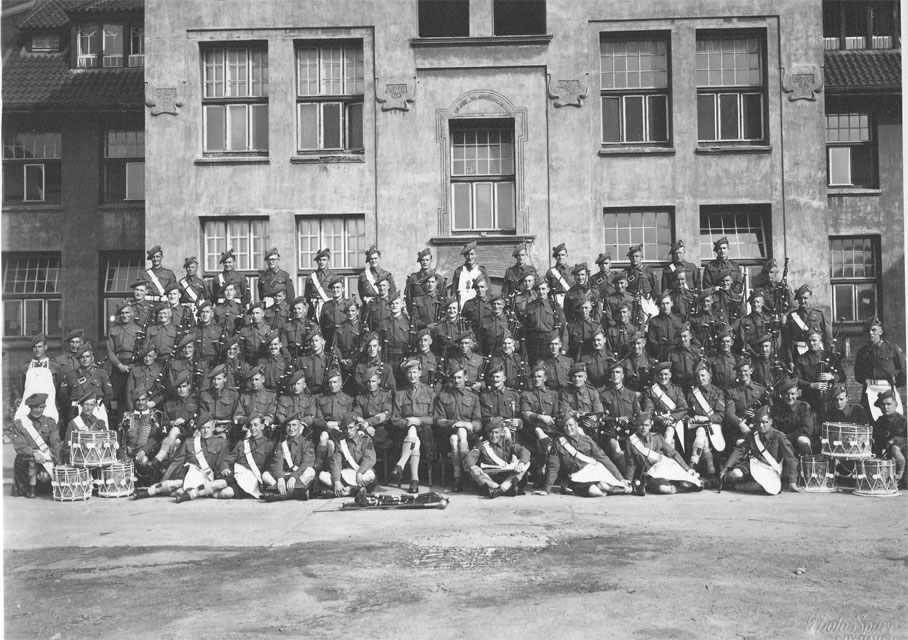
Group photograph of all the members
of British and Canadian Seaforths Pipe Bands, 1945, Cuxhaven.
Pipe Major Edmund Esson is seated in the middle
of the front row, next to the commanding Officer.

Seaforth Highlanders Sporran Badge
The move to Castle Eyckenstein in
Maartensdijk, municipality de Bilt

the beautiful Castle Eyckenstein in
Maartensdijk, municipality de Bilt.
Now the Canadian Seaforths
were to forever become historically linked to a Dutch castle !
For on 19 juni 1945 the
Seaforth Highlanders of Canada moved from Amsterdam to Castle Eyckenstein in
Maartensdijk, municipality de Bilt
which had been requisitioned for them by the Canadian Army.

From The Seaforth
Highlanders of Canada 1919/1965, p.443:
However, on 19 June the Seaforths were moved to
the small rural village of Maartensdijk, located midway between
Utrecht and Hilversum. It was a pleasant spot, somewhat like the
south of England but flat, criss-crossed with dykes and water
ditches, and with little local entertainment potential except
for a nearby lake.
Hilversum and Utrecht were not far away. however,
and there were numerous opportunities to send men away on leave,
both to the United Kingdom and to such places as Paris, Brussels
and Amsterdam.
From
there they finally left in January
1946, after Beating the Retreat at Bilthoven
(see the Canada's Weekly
photographs below here). Two days after arrival at Eyckenstein, one of the
Canadian soldiers carved his name: "W. Foster", in a beech tree,
with the badge of his unit
(Take a look at the
photographs of this below here).
According to Canadian military
records the full name of the soldier
who did carve his name in the tree on June 21, 1945 probably was W.C. Foster. W.C. Foster
did serve with The Seaforth Highlanders of Canada from 18 december
1944 till 18 July 1945.


Carving in a beech tree:"W. Foster
21.6.45" Badge of the Canadian unit "The
Seaforth Highlanders of Canada"